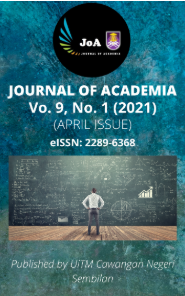WASHFASTNESS PROPERTIES OF DYED PINEAPPLE LEAF FIBRE USING DIFFERENT DYEING TECHNIQUES
Keywords:
pineapple leaf fibre, infrared dyeing, exhaustion dyeing, colourfastness properties, washingAbstract
Pineapple leaf is categorised as natural fibre resources hence creating an initiative to reduce usage of synthetic fibre. Pineapple fruits commercially have high demand in the industry causing the leaves discarded as agricultural waste. As an alternative to reduce the waste, fibres from pineapple leaf were extracted and dyed to improve the aesthetic value of pineapple leaf fibre by adding dyeing substrates using low energy consumption approach. This research is the first step towards more profound understanding on the nature of colourfastness properties pineapple leaf dyed fibre in addition on the improvement of dyeing behaviour properties. This method could further be refined by considering the production of textile materials, which can provide alternative on the usage of highly expensive silk fibres in the songket making industry. Two different methods of dyeing were used to analyse the colourfastness properties of pineapple leaf fibres. Pineapple leaf fibre was extracted using mechanical extraction. The fibres were manually extracted by water retting process and dried at room temperature prior to dyeing. Red reactive dye was applied to the pineapple leaf fibres using infrared dyeing machine and exhaustion dyeing machine. Both dyeing techniques displayed interesting colour findings, where infrared dyeing with golden shade and exhaustion dyeing with a reddish shade. Both dyeing techniques gave excellent colourfastness to washing with the moderate performance of change in colour.
References
Asim, M., Abdan, K., Jawaid, M., Nasir, M., Dashtizadeh, Z., Ishak, M. R., & Hoque, M. E. (2015). A Review on Pineapple Leaves Fibre and Its Composites. International Journal of Polymer Science, 2015, 1-16. doi: 10.1155/2015/950567
Bafana, A., Devi, S. S., & Chakrabarti, T. (2011). Azo dyes: past, present and the future. Environmental Review, 19 ((NA)), 350-371. doi: https://doi.org/10.1139/a11-018
Balakrishnan, S., Wickramasinghe, G. L. D., & Wijayapala, U. G. S. (2019). Study on dyeing behavior of banana fiber with reactive dyes. Journal of Engineered Fibers and Fabrics, 14, 155892501988447. doi: 10.1177/1558925019884478
Banika, S., Nag, D., & Debnath, S. (2011). Utilization of pineapple leaf agro-waste for extraction of fibre and the residual biomass for vermicomposting. Indian Journal of Fibre & Textile Research 36, 172-177.
Burkinshaw, S. M., & Salihu, G. (2019). The role of auxiliaries in the immersion dyeing of textile fibres: Part 9 practical aspects of the role of inorganic electrolytes in dyeing cellulosic fibres with pure reactive dyes. Dyes and Pigments, 161, 628-641. doi: 10.1016/j.dyepig.2017.10.014
Chattopadhyay, D. P. (2011). Chemistry of dyeing. In Handbook of textile and industrial dyeing. Woodhead Publishing. pp. 150-183.
Chen, Q., Zhao, T., Wang, M., & Wang, J. (2013). Studies of the fibre structure and dyeing properties of Calotropis gigantea, kapok and cotton fibres. Coloration Technology, 129(6), 448-453. doi: 10.1111/cote.12051
Kappe, C. O., & Dallinger, D. (2009). Controlled microwave heating in modern organic synthesis: highlights from the 2004-2008 literature. Mol Divers, 13(2), 71-193. doi: 10.1007/s11030-009-9138-8
International Organization for Standardisation. (1993). Tests for coloured textiles and colorants – Requirements with guidance for use (ISO Standard No. 105-A02:1993). https://www.iso.org/standard/3785.html.
International Organization for Standardisation. (2006). Tests for coloured textiles and colorants – Requirements with guidance for use (ISO Standard No. 105-C10:2006). https://www.iso.org/standard/31775.html.
International Organization for Standardisation. (2019). Tests for coloured textiles and colorants – Requirements with guidance for use (ISO Standard No. 105-A03:2019). https://www.iso.org/standard/75985.html.
Lux, C., Lubio, A., Ruediger, A., Robert, S., & Muehlethaler, C. (2019). Optimizing the analysis of dyes by Surface-Enhanced Raman Spectroscopy (SERS) using a conventional-microwave silver nanoparticles synthesis. Forensic Chemistry, 16, 100186. doi: 10.1016/j.forc.2019.100186
Mat Nayan, N. H., Abd Razak, S. I., & Wan Abdul Rahman, W. A. (2014). Biopulping by Ceriporiopsis subvermispora towards Pineapple Leaf Fiber (PALF) Paper Properties. Advanced Materials Research, 1043, 180-183. doi: 10.4028/www.scientific.net/AMR.1043.180
Salleh, J., Yusoh, M.K., & Ruznan, W. S. (2015). Tensile Strength of Some Natural-Fibre Composites. Pertanika Journal of Tropical Sciences, 38(4), 575-582.
Shah, M., F. (2020). Govt to Expand Pineapple Cultivation with Booming Global Demand. The Stars. https://www.thestar.com.my/news/nation/2020/06/12/govt-to-expand-pineapple-cultivation-with-booming-global-demand. [Access online 30 October 2020].
Downloads
Published
Issue
Section
License
Copyright (c) 2021 Journal of Academia

This work is licensed under a Creative Commons Attribution-NonCommercial-NoDerivatives 4.0 International License.












